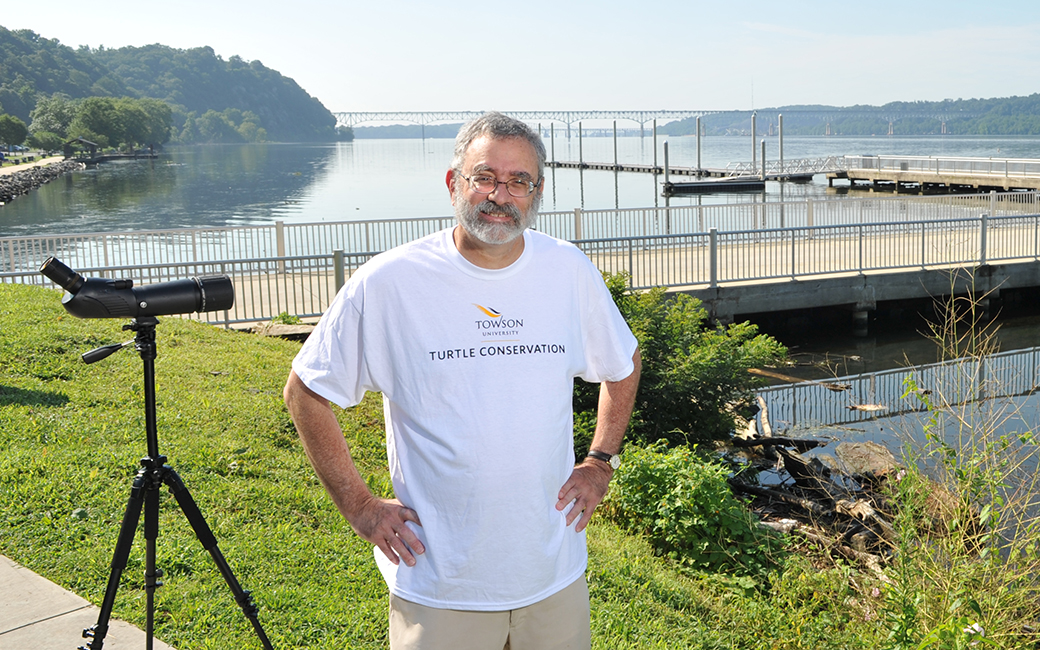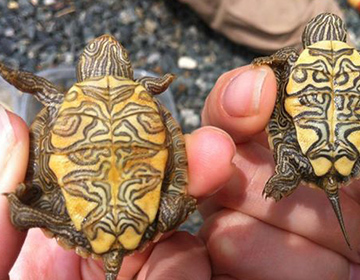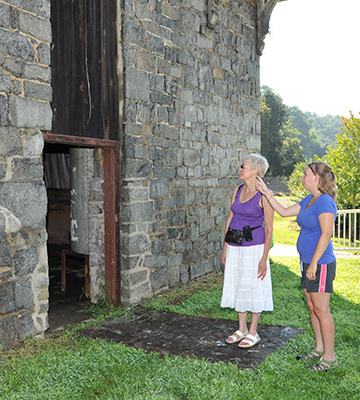Back on the Map
A Towson professor and his students work to save an endangered turtle - with a little help from an entire town.

An endangered species is discovered in a rural river community. Conservationists descend on the town. Residents are wary that the outsiders will change their way of life. Misunderstanding becomes mistrust, and conflict soon erupts.
It’s exactly the story you’d expect. But it’s not the one you’ll find here.
That’s because in the small northeastern Maryland town of Port Deposit—where Towson University biology professor Richard Seigel and a team of students have been working to save the endangered northern map turtle since 2008—the opposite is happening.
Together with remarkable support from the community and other partners, the efforts of Seigel and his students have become a model of unprecedented cooperation as they work to change the fate of a timid turtle.
Slow and Steady
The northern map turtle—named for the pattern on its shell that resembles contour lines on a map—is a shy species. It's known to retreat at the slightest sign of a potential threat, even a passing shadow.

So, in 2008 when Seigel and his research team discovered a nesting map turtle population at a busy marina along the banks of Maryland's Susquehanna River, it wasn't just a major find. It was a major surprise.
"It's really the last place you'd expect an active nesting population of an endangered turtle," he says.
The turtles’ path through town is a treacherous one—leading them across a gravel parking lot to nests along a chain link fence, just yards from nearby railroad tracks. Considering that development, boating, and loss of habitat have contributed to the turtle’s decline throughout the Susquehanna, this isn't exactly the safest spot to hatch their young.
Watch video of the turtles crossing the parking lot
Since discovering the turtles, the researchers have worked tirelessly to study and strengthen the population in Port Deposit. The conservation efforts focus on making the area safer for the endangered turtles without impacting the town's other important population—people.
Plans for shoreline restoration will ensure the turtles have more options to enter and exit the water. A wildlife exclusion fence will allow them to access their nests without crossing parking lots or roads. And a combined research facility and ecotourism center will be established at the Tome Gas House, an existing historic structure at the site.
The team is also working hard to solve another major threat to the turtles: the loss of basking sites in and around the Susquehanna.
“Turtles, like all reptiles, are solar powered,” explains Seigel. “They need to bask in the sun to maintain their body temperature, digest food, and gear up for mating and nesting.”
Constant changes in water level caused by the nearby Conowingo Dam and hydroelectric plant prevent the turtles from accessing the many boulders in the river that have traditionally served as basking sites.
To solve the problem, Seigel and his team are developing floating platforms that will rise and fall with the water level.
Turtle Power
The conservation work is funded by a growing roster of partners, including the Exelon Nuclear Corporation, Maryland State Highway Administration and Maryland Department of Natural Resources. But most extraordinary is the involvement of the town of Port Deposit itself.
In May 2013, TU and Port Deposit entered a formal partnership for the conservation effort. The town adopted the map turtle as its mascot and is looking to ecotourism to drive economic growth and protect the turtle at the same time. The local love for the turtle even led one musician to write a song inspired by the species.
Hear the map turtle song on Facebook
“It’s one of those rare times in conservation biology where you don’t have polarization and you don’t have conflicting interests,” says Seigel. “Everyone is working together for a common goal and realizing that you can have an endangered species, and commerce, and development, and tourism, all at once.”
“ Everyone is realizing you can have an endangered species, commerce, development and tourism all at once. ”
Teal Richards-Dimitrie ’10 was a graduate student in biology when she began work on the project. Now employed by the Massachusetts Department of Fisheries and Wildlife, for years she was the driving force for educating the public about the turtle and ultimately winning the community’s support for conservation.
“The people of Port Deposit have been so supportive from the very beginning,” she says. “I would tell one person about something we were doing, and the next thing I knew everyone in town was talking about it and asking how they could help.”

It’s a project that pays off for the town, the turtles and Towson students.
“Towson has always had tremendous pride in offering experiential learning,” says Seigel. “This summer I had a student who would have worked as a valet if he weren’t on this project. Another student would have waited tables if she weren’t here. Instead, they worked 40 hours a week in conservation biology, doing something that will advance their careers.”
Seigel is sure the experience will take his students far. After all, “saved endangered species” is a pretty impressive resume builder.
Funding the Research
Join us in the effort to put the endangered turtles back on the map. So far, Professor Seigel and the team have pulled together remarkable support from the community and other partners. We need your help to continue this project. Make a tax-deductible gift today to help fund shoreline restoration, build a wildlife exclusion fence, and establish a combined research facility and ecotourism center. Give now.
By Dan Fox.
Photos by Kanji Takeno.
Video by Ron Santana and Kiel McLaughlin.
Top photo: Northern map turtle (Scott McDaniel)